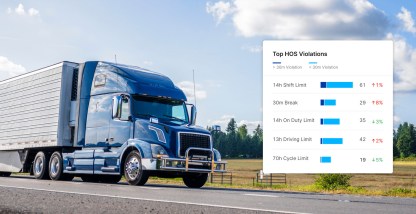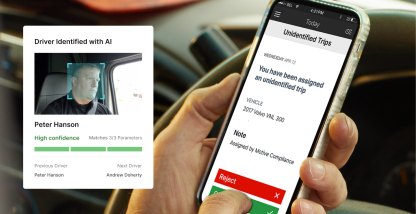On June 1, 2020, the FMCSA published changes to the Hours of Service of Drivers Final Rule containing four revisions to the current Hours of Service (HOS) regulations for commercial motor vehicle drivers across the U.S.
With these new Hours of Service changes, the FMCSA is addressing many of the concerns voiced by carriers and drivers during the public comment period. The goal is to increase flexibility without compromising safety.
This article explains the timeline of the HOS changes, the four revisions to the HOS regulations, and how Motive is making it easy for our customers to take advantage of them.
When are the FMCSA’s new Hours of Service rules effective?
The new Hours of Service rules become effective September 29th, 2020. At that point, drivers will be able to fully benefit from the flexibility offered by the new HOS rules. And your experience with Motive will be seamless.
What are the changes to the FMCSA’s Hours of Service rules?
There are four revisions to the FMCSA’s Hours of Service regulations. The new Hours of Service changes include the following.
- The Short-Haul Exemption,
- 30-minute Break Period,
- Split-Sleeper Berth, and
- The Adverse Driving Conditions Exemption
1. Short-haul exemption
Old requirement
- Drivers using the 395.1(e)(1) short-haul exemption (100 air-mile radius) may not be on-duty for more than 12 hours.
Revised requirement
- Extends the maximum radius of the 395.1(e)(1) short-haul exemption from 100 to 150 air-miles.
- Extends the maximum duty period allowed under the 395.1(e)(1) short-haul exception from 12 hours to 14 hours.
2. 30-minute break period
Old requirement
- If more than 8 consecutive hours have passed since the last off-duty, or sleeper-berth, period of at least half an hour, a driver must take an off-duty break of at least 30 minutes before driving.
Revised requirement
- Requires a 30-minute break only when a driver has driven 8 hours without taking a 30-minute break.
- If required, the 30-minute break may be satisfied by any non-driving period of 30 minutes. Such as on-duty, off-duty, or sleeper berth time.
3. Split sleeper berth
Old requirement
- A driver can use the sleeper berth to get the “equivalent of at least 10 consecutive hours off-duty.”
- To do this, the driver must spend at least 8 consecutive hours, but less than 10 consecutive hours, in the sleeper berth.
- This rest period does not count as part of the 14-hour limit. A second, separate rest period must be at least 2, but less than 10, consecutive hours long. This period may be spent in the sleeper berth, off-duty, or sleeper berth and off-duty combined. It does count as part of the maximum 14-hour driving window.
Revised requirement
- Modifies the sleeper berth requirements to allow drivers to take their required 10 hours off-duty in two periods, provided one off-duty period (whether in or out of the sleeper berth) is at least 2 hours long and the other involves at least 7 consecutive hours spent in the sleeper berth.
- Neither period counts against the maximum 14-hour driving window.
Further reading:- The Complete Guide to Canada Hours of Service Rules
4. Adverse driving conditions exemption
Old requirement
- A driver may drive and be permitted or required to drive a CMV for no more than 2 additional hours beyond the maximum time allowed. However, this does not currently extend the maximum “driving windows.”
Revised requirement
- Allows a driver to extend the maximum “driving window” by up to 2 hours during adverse driving conditions as well as 2 additional hours of driving time.
- Drivers with a maximum driving window of 14 hours can use the adverse driving condition exception to complete their drive time in a 16-hour driving window.
- This change applies both to drivers of property-carrying CMVs (14-hour “driving window”) and passenger-carrying CMVs (15-hour “driving window”).
How Motive is helping our customers comply with the new Hours of Service rules
There is no requirement for ELD providers to support the new Hours of Service changes when they go into effect on September 29th. It’s expected that many ELD companies won’t support the new HOS rules for some time.
Motive understands the value this additional flexibility brings to our customers and expedited the development process to ensure that these changes will be reflected in the appropriate “cycle rule” in the system.
On September 29th, Motive customers will be able to take advantage of the new Hours of Service rules*. The only action required by our customers is to have your drivers upgrade their Motive Driver App to the latest version.
We encourage enabling automatic updates for the Motive Electronic Logbook App on your internet-connected iOS or Android smart device so that you will always be using the most up-to-date version.
If you’re a Motive customer and have questions about how we’re supporting the new Hours of Service rules, give us a call at 855-434-3564 or send us an email at HOSChanges@gomotive.com
If you’re not a Motive customer and want to benefit from the additional flexibility offered by the new Hours of Service rules with the Motive ELD solution. Schedule a demo or get a personalized quote today.
*The adverse driving conditions exception will be built into our violation alert and drive time clock calculation logic for all applicable cycle rules in a future app release rather than in v32. In the meantime, drivers operating under this exception may do so legally by adding a detailed annotation to their record explaining their circumstances and disregard any applicable violation alerts.








